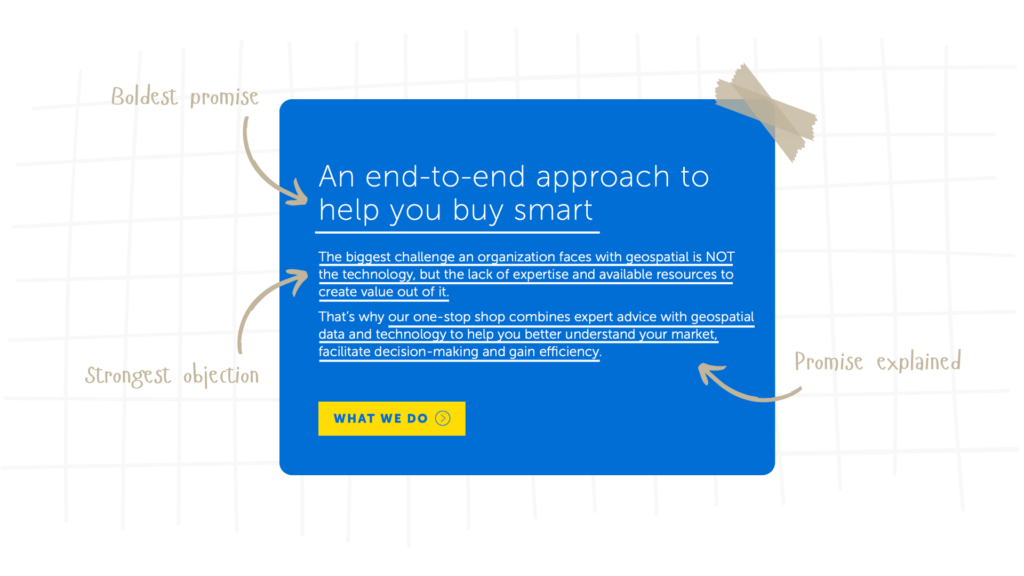At least once a week, I audit a geospatial company’s website and think “I have no idea what this company actually does.”
And that’s despite having a masters degree in GIS and 15 years of industry experience.
Chances are, your customers feel the same.
Because many (most?) geospatial websites are ineffective.
They don’t tell visitors what the company does, who they do it for, or how they do it better / different than the competition.
Which is a MASSIVE roadblock when it comes to conversion.
So let’s break down what an effective home page should communicate, and how to structure your messages to help your audience:
💡 Understand they’re in the right place
💡 Perceive the value of what you do
💡 Feel spoken to and understood
💡 Believe you’re credible
💡 Know you’re the right choice
Let’s start with your Hero section
What to include the hero section of your geospatial company’s website
There are 4 key questions your hero section should answer to help your customers move along in their buyers journey. These are
- Which problem do you solve?
- What do you do?
- Who is it for?
- Why is it better?
Here’s what that could look like:
(Real-world example from Korem, a geospatial company who nails this)

Next, follow up on your “promise” by explaining how you do what you claim.
Next, explain how
Now that you’ve got your audience’s attention, you need to quickly prove your UVP.
That means explaining and expanding upon your hero section.
Specifically, you should:
- Acknowledge the strongest objection
- Make the boldest promise you can back up
- Explain how the strong promise is believable
Here’s what that could look like:

Then, show proof
Once you’ve clearly outlined what you do, who for, and why it matters, you need to prove that it works. This can be:
- Through social proof (logos, testimonials)
- Quantitative proof (numbers, case studies)
- Demonstrated proof (product demo)
This is crucial for building trust with your audience and supporting your argument with strong customer voices
Here’s what that could look like:

Next come your benefits
After building your argument and showing proof, it’s time to bring in your benefits, features, or proof points, e.g.,
- Answer the question “why us”?
- Explain key benefits related to your UVP
- Showcase your most compelling features
There are likely several geospatial companies your customers can choose from, so give them a compelling reason to choose you!
Here are examples of different types of benefit sections:

Then it’s time to split your customer journey
Everything up to this point will have been directed at your global audience; i.e., everyone you serve.
But most geospatial companies have more than one audience group. And different customer segments require different, more nuanced messaging.
That’s why it’s a good idea to split the customer journey at this point of the home page, by giving an overview of your use cases or personas. That way, you can give a deeper dive into what your product is and explain how it works for different audiences or use cases.
- Examples of use cases: forestry, healthcare, transportation, local govt, etc.
- Examples of audiences: data analysts, engineers, CTOs, etc.
From this overview, you can link off to more in-depth pages for each respective audience group, where their individual customer journeys continue.
Those still reading, likely want to know how it works
After you’ve given people the chance to self-select into a more specific customer pathway, only the most knowledge hungry prospects will still be reading.
These are the folks who are still at an earlier stage of customer awareness and want to find out the exact way your product or software works.
You can cater to the needs of these readers by:
- Either explaining the step-by-step process of working with your product
- Or showing a schematic overview, e.g. the data streams coming in and the output
Lastly, don’t forget your call to action
Don’t leave your readers hanging at the end of the page! Instead, tell them where to go next, what their options are, and what the next steps look like if they contact you or sign up.
Remove as much uncertainty as possible, and truly guide the process each step of the way.
Need help optimising your geospatial website? Get in touch to enquire about a free audit, or check out our website copywriting services.
